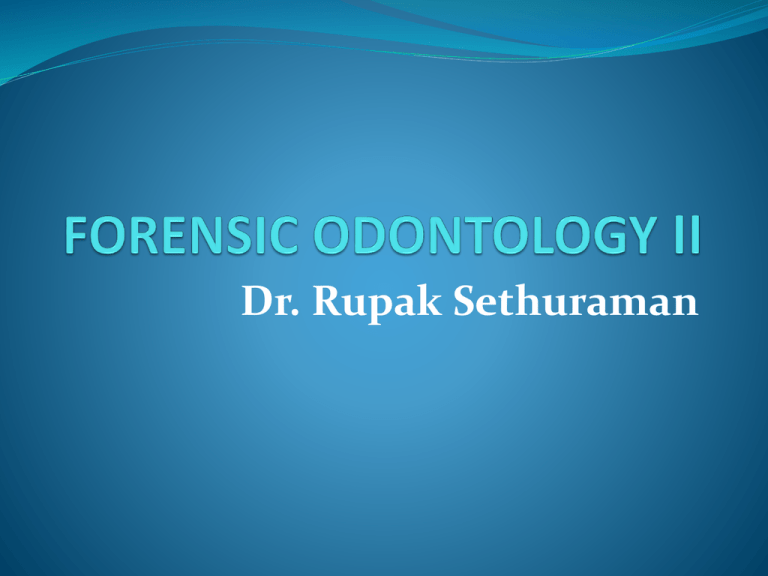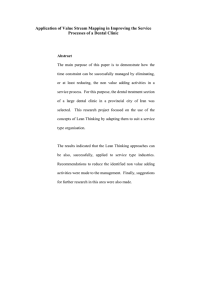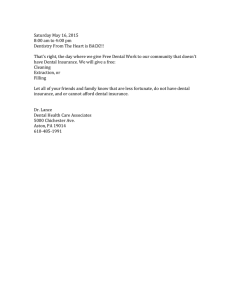Forensic Odontology II
advertisement

Dr. Rupak Sethuraman SPECIFIC LEARNING OBJECTIVE Age estimation using forensic odontology. Meaning and importance of bite marks and lip prints in forensic investigation. FORMAT Guidelines for dental identification Palatal Rugae in Identification Bite marks and their analysis Lip prints and their use in Forensic Science GUIDELINES FOR DENTAL IDENTIFICATION The postmortem dental evidence is gathered by photographic, radiographic and charting techniques. Photographs should be taken of full head and face views. Images of the occlusal planes of both dental arches and individual views of unusual pathologic or restorative findings are also obtained. Dental impressions and jaw resection may also be required after the initial full head photographs have been obtained. While obtaining postmortem radiographic evidence, it is difficult to place intraoral radiographic film securely against the mandible or maxilla . To overcome this difficulty, a self supporting film holder has been identification. developed for postmortem The maxilla can be split along the midsagittal suture and each half can be placed horizontally on an occlusal film. Similar exposures can be obtained from the mandible by mounting the jaw on the edge of a table and placing an occlusal film under the supporting half. THE PALATAL RUGAE IN IDENTIFICATION Rugae patterns are considered unique to an individual. The location of palatal rugae is such that it is usually preserved even in cases of severe trauma. Various patterns and types of rugae have been identified. Rugae patterns on the dead person’s maxillary dentures may be compared to old dentures that may be recovered from his residence, or plaster model from dental office. DENTAL PROFILING This is used when ante-mortem records are not available. Includes a triad of information ethnic origin , gender , age Information from this process will enable a more focused search for ante-mortem records. Dental features have complex mode of inheritence and are combination of heredity and environmental factors to which person is exposed so different populations show considerable variation in Dental features. Dental features in population divided into 1) Metric(tooth size) 2) Non metric(tooth shape) - more heritable & dependable DENTAL AGE ESTIMATION Age estimation in prenatal, neonatal and early post natal child - by use of histologic technique; by radiographs; neonatal line indicates a live birth; by dry weight of mineralized tooth (at six months Intra Uterine - 60mg, newborn-0.5g, six months post natal1.8g). Age estimation in children and adolescents - two events may be used which are eruption and tooth calcification. Age estimation in adults – most difficult, various methods are used - Gustafson’s method is the most common. CRIME INVESTIGATION BITE MARKS: A mark caused by teeth either alone or in combination with other mouth parts (Mac Donald). May be caused by humans or animals; may be on tissue, food items or other objects. GUIDELINES ANALYSIS FOR BITE MARK 1. Description of the bite mark 2. Evidence collection -Examination of the victim and suspect -Photography of the bite marks -Saliva evidence to identify blood group antigens and DNA. - Impressions and study casts. -Tissue samples of a bite mark from the dead person. 3. Evidence Analysis- The responsibility of comparing the photographs of the bite pattern injury with the dentition of the suspect is the responsibility of the forensic dentist. The forensic dentist first determines whether the pattern is truly a result of biting or due to some artifact. Once it is established that the pattern is related to the teeth, it can be matched to the suspect’s dentition . LIP PRINTS Examination of lip print- cheiloscopy Grooves on the lips are heritable and supposed to be individualistic so material evidence left at a crime scene is similar to finger prints. Any questions?? Thank you





